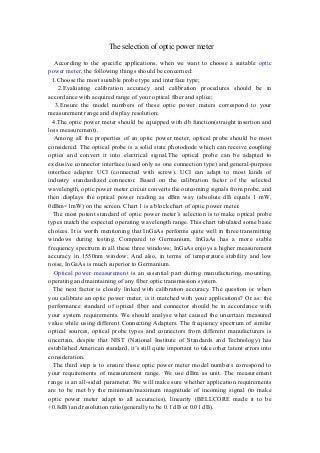
20131212(2)
- 1. The selection of optic power meter According to the specific applications, when we want to choose a suitable optic power meter, the following things should be concerned: 1.Choose the most suitable probe type and interface type; 2.Evaluating calibration accuracy and calibration procedures should be in accordance with acquired range of your optical fiber and splice; 3.Ensure the model numbers of these optic power meters correspond to your measurement range and display resolution; 4.The optic power meter should be equipped with db function(straight insertion and loss measurement). Among all the properties of an optic power meter, optical probe should be most considered. The optical probe is a solid state photodiode which can receive coupling optics and convert it into electrical signal.The optical probe can be adapted to exclusive connector interface (used only as one connection type) and general-purpose interface adapter UCI (connected with screw). UCI can adapt to most kinds of industry standardized connector. Based on the calibration factor of the selected wavelength, optic power meter circuit converts the outcoming signals from probe, and then displays the optical power reading as dBm way (absolute dB equals 1 mW, 0dBm=1mW) on the screen. Chart 1 is a block chart of optic power meter. The most potent standard of optic power meter’s selection is to make optical probe types match the expected operating wavelength range. This chart tabulated some basic choices. It is worth mentioning that InGaAs performs quite well in three transmitting windows during testing. Compared to Germanium, InGaAs has a more stable frequency spectrum in all these three windows; InGaAs enjoys a higher measurement accuracy in 1550nm window; And also, in terms of temperature stability and low noise, InGaAs is much superior to Germanium. Optical power measurement is an essential part during manufacturing, mounting, operating and maintaining of any fiber optic transmission system. The next factor is closely linked with calibration accuracy. The question is: when you calibrate an optic power meter, is it matched with your applications? Or as: the performance standard of optical fiber and connector should be in accordance with your system requirements. We should analyse what caused the uncertain measured value while using different Connecting Adapters. The frequency spectrum of similar optical sources, optical probe types and connectors from different manufacturers is uncertain, despite that NIST (National Institute of Standards and Technology) has established American standard, it’s still quite important to take other latent errors into consideration. The third step is to ensure those optic power meter model numbers correspond to your requirements of measurement range. We use dBm as unit. The measurement range is an all-sided parameter. We will make sure whether application requirements are to be met by the minimum/maximum magnitude of incoming signal (to make optic power meter adapt to all accuracies), linearity (BELLCORE made it to be +0.8dB) and resolution ratio(generally to be 0.1 dB or 0.01 dB).
- 2. The most important thing in optic power meter selection is that optical probes match the expected working range. The fourth thing is that most optic power meters have equipped with dB function (relative power), as directly reading optical loss is quite practical in measurements. Optic power meter in at low prices don’t support this. Without dB function, technologists have to record reference values and measured values respectively, and calculate their difference values. Because of the relative loss measurement function, users can raise productivities and reduce manually calculating errors. Today, the choices of basic characteristics and functions of optic power meters become decreased for users. But special requests including recording data collecting history and peripheral interface are made by some users. stabilized light source During the process of loss measurement, stabilized light source(SLS) emit the light whose power and wavelength are already known into light system. Those optic power meters /optical probes which can calibrate specific wavelength light source(SLS) receive the light from optical network and convert it into electrical signal. To ensure the accuracy of loss measurement, the transmission equipments used in light source simulation should : 1.have same wavelength, and use the same light source(LED, laser); 2.keep the stability of output power and frequency spectrum(the stability of time and temperature) during measuring. 3.provide the same connecting interfaces and use the same optical fiber; 4.ensure the output power meets system loss at anytime. The best choice of light source should simulate characteristics and measurement requirements of systematic optical transmitter and receiver when the transmission system need a solitary and stabilized light source. In terms of light source selection, things should be concerned are: Laser Diode(LD) The light from Laser Diode has a narrow wavelength bandwidth. And it’s monochromatic light, that is to say its single wave is long. Compared with LED, laser which passes through its spectral band is discontinuous, and it emits several wave lengths whose peak values are low in the two sides of the central wavelength. Compared with LED light sources, laser light sources are much more expensive than it despite that laser light sources are proved to be more powerful. Generally Laser Diodes are used in long distance single-mode systems whose losses are more than 10dB. We should try to not use laser light sources in multimode fiber measurements. Light Emitting Diode(LED) LED has a wider spectrum than LD, generally it’s from 50 to 200nm. And its output power is more stable because LED is a kind of non-interference light. LED light sources are much cheaper than LD light source, but it’s underpower when the loss measurement at worst condition. LED light sources are typically used in Local Area Network(LAN) of short distance networks and multimode fibers. When LED has enough output power, it can be used in laser light source single mode system to conduct an accurate loss measurement.